snow chains MITSUBISHI L200 2018 Owner's Manual (in English)
[x] Cancel search | Manufacturer: MITSUBISHI, Model Year: 2018, Model line: L200, Model: MITSUBISHI L200 2018Pages: 466, PDF Size: 28.42 MB
Page 14 of 466

Exterior - rearE085004025921. Tyre inflation pressures p. 10-12Changing tyres p. 8-17
Tyre rotation p. 10-13
Snow tyres p. 10-14
Tyre chains p. 10-14
2. Tail and stop lamps p. 5-17, 10-23, 10-28
3. Rear turn-signal lamps p. 5-20, 10-23, 10-28
4. Reversing lamps p. 10-23, 10-28 Rear fog lamp (driver’s side) p. 5-22, 10-23, 10-28
5. Spare wheel p. 8-17
6. Licence plate lamp p. 5-16, 10-23, 10-29
7. Rear gate p. 3-20
8. High-mounted stop lamp p. 10-23
Exterior - rear
1-12OKTE18E1Overview/Quick guide1Single cab
Page 15 of 466
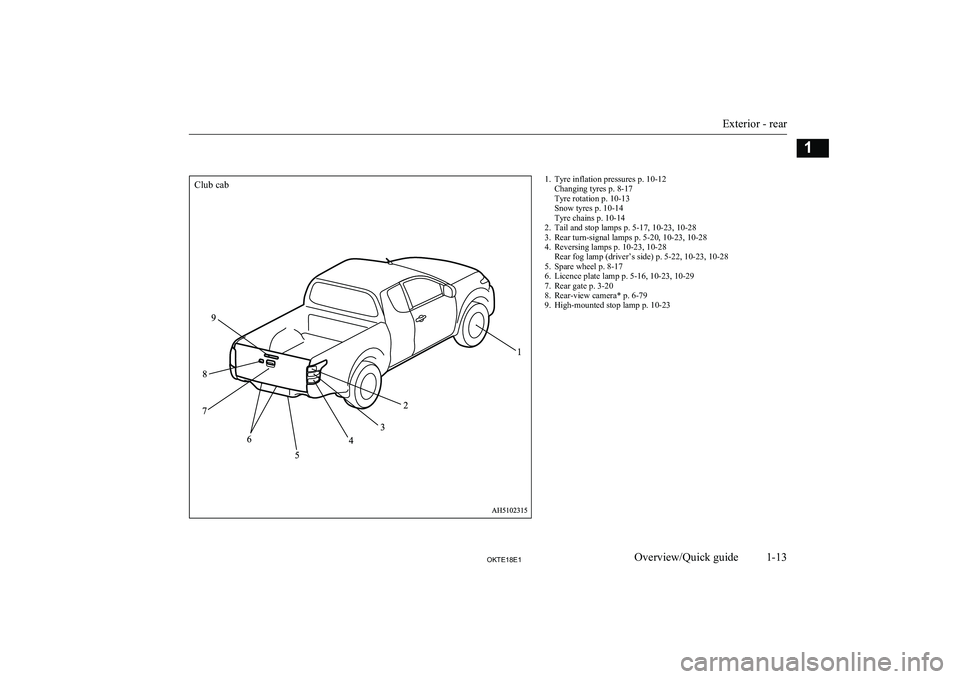
1. Tyre inflation pressures p. 10-12Changing tyres p. 8-17
Tyre rotation p. 10-13
Snow tyres p. 10-14
Tyre chains p. 10-14
2. Tail and stop lamps p. 5-17, 10-23, 10-28
3. Rear turn-signal lamps p. 5-20, 10-23, 10-28
4. Reversing lamps p. 10-23, 10-28 Rear fog lamp (driver’s side) p. 5-22, 10-23, 10-28
5. Spare wheel p. 8-17
6. Licence plate lamp p. 5-16, 10-23, 10-29
7. Rear gate p. 3-20
8. Rear-view camera* p. 6-79
9. High-mounted stop lamp p. 10-23
Exterior - rear
1-13OKTE18E1Overview/Quick guide1Club cab
Page 16 of 466
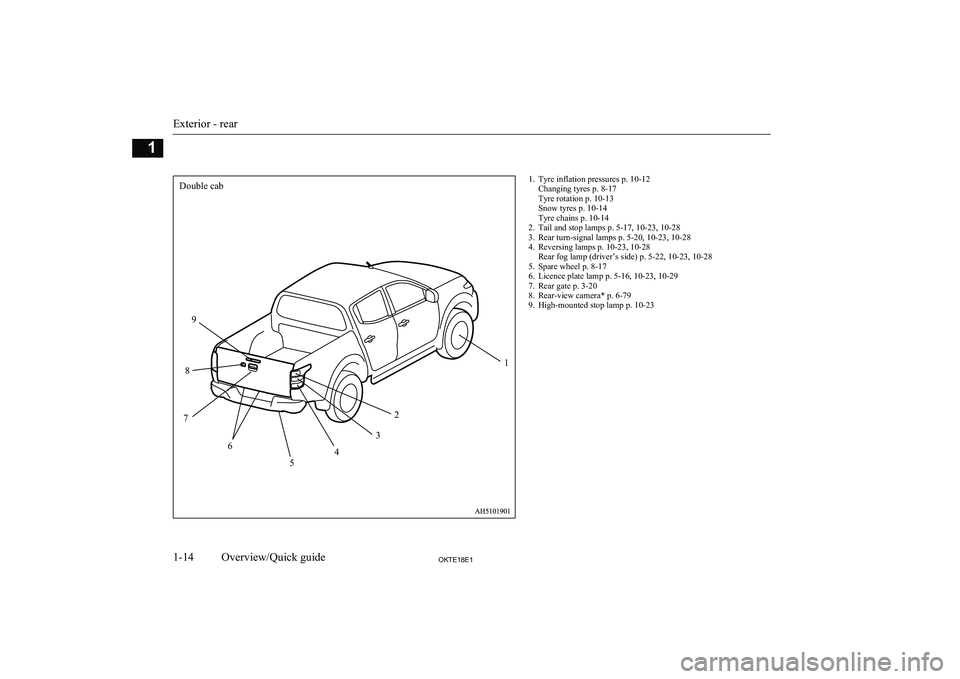
1. Tyre inflation pressures p. 10-12Changing tyres p. 8-17
Tyre rotation p. 10-13
Snow tyres p. 10-14
Tyre chains p. 10-14
2. Tail and stop lamps p. 5-17, 10-23, 10-28
3. Rear turn-signal lamps p. 5-20, 10-23, 10-28
4. Reversing lamps p. 10-23, 10-28 Rear fog lamp (driver’s side) p. 5-22, 10-23, 10-28
5. Spare wheel p. 8-17
6. Licence plate lamp p. 5-16, 10-23, 10-29
7. Rear gate p. 3-20
8. Rear-view camera* p. 6-79
9. High-mounted stop lamp p. 10-23
Exterior - rear
1-14OKTE18E1Overview/Quick guide11
2
3
4
5
6
7 8 9
Double cab
Page 167 of 466

4-wheel drive operation*E00606602487
By selecting 4-wheel drive, both axles of the
vehicle are rigidly connected with each other. This improves the traction characteristics. When turning sharp corners or moving for-
ward and backward repeatedly, however, the drive line is stressed, which is felt as a brak-
ing effect. A 4-wheel drive vehicle can accel-
erate more quickly and smoothly.
However, note that the braking distance is not shorter than that of a rear-wheel drive ve-hicle.
When using 4-wheel drive on rough roads
(snow, mud, sand, etc.), it is important to op- erate the vehicle correctly.NOTEl The driving posture should be more upright
and closer to the wheel than usual; adjust the
seat to a good position for easy steering and pedal operation. Be sure to wear the seatbelt.
l After driving on rough roads, check each
part of the vehicle and wash it thoroughlywith water. Refer to the “Vehicle care” sec-
tion and “Inspection and maintenance fol-
lowing rough road operation” on page 6-51.Driving on dry paved road and
highway
Select “2H” position (Easy Select 4WD),
“2H” or “4H” position (Super Select 4WD II) to drive on the dry paved road. Especially on
dry highway, never select the “4H” or “4L”
position (Easy Select 4WD), “4HLc” or “4LLc” position (Super Select 4WD II).
CAUTIONl Selecting “4H” or “4L” position (Easy Se-
lect 4WD), “4HLc” or “4LLc” position (Su-
per Select 4WD II) to drive on dry paved
road will increase the fuel consumption with possible noise generation and early tyrewear.
It may also increase the differential oil tem- perature, resulting in possible damage to the
driving system.
Further, the drive train will be subjected to excessive loading, possibly leading to oil
leakage, component seizure, or other serious faults.Driving on snowy or icy roads
Set the drive mode-selector to “4H” position
(Easy Select 4WD), “4H” or “4HLc” position in accordance with the road conditions (Su-
per Select 4WD II) and then gradually de-
press the accelerator pedal for a smooth start. Keep the pressure on the accelerator pedal asconstant as possible, and drive at low speed.
NOTEl The use of snow tyres and/or tyre chains is
recommended.
l Maintain a safe distance between vehicles,
avoid sudden braking, and use engine brak-
ing (downshifting).CAUTIONl Avoid sudden braking, sudden acceleration,
and sharp turning; such operations could
cause skidding and spinouts.
Driving on sandy or muddy
roads
Set the drive mode-selector to “4H” or “4L”
position (Easy Select 4WD), “4HLc” or “4LLc” position (Super Select 4WD II) and then gradually depress the accelerator pedal
for a smooth start. Keep the pressure on the accelerator pedal as constant as possible, and drive at low speed.
4-wheel drive operation*
6-49OKTE18E1Starting and driving6
Page 175 of 466
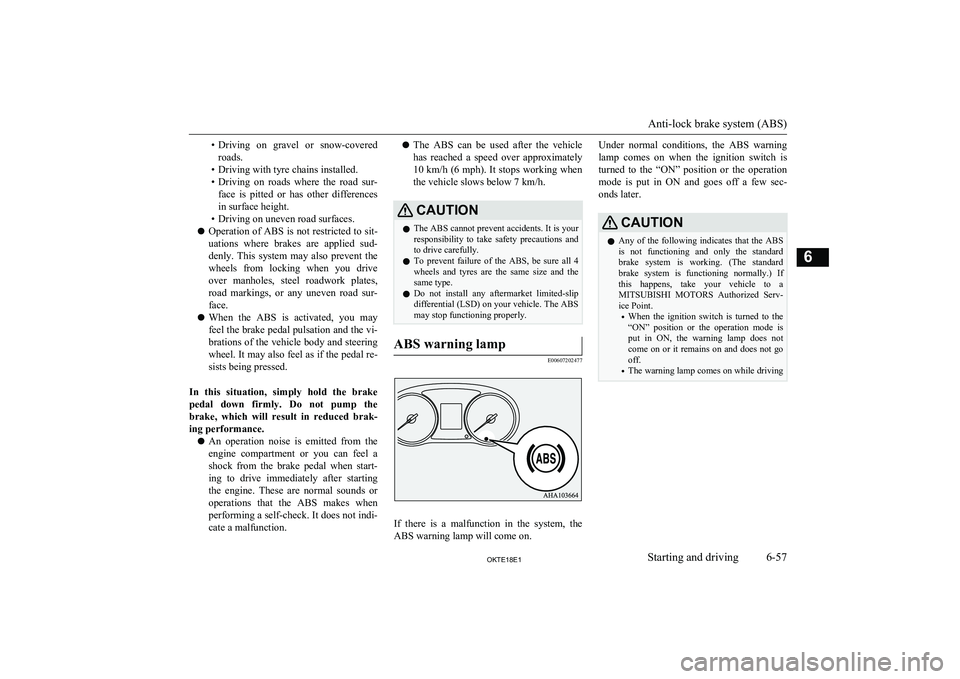
•Driving on gravel or snow-covered
roads.
• Driving with tyre chains installed.
• Driving on roads where the road sur-
face is pitted or has other differences in surface height.
• Driving on uneven road surfaces.
l Operation of ABS is not restricted to sit-
uations where brakes are applied sud-denly. This system may also prevent the
wheels from locking when you drive over manholes, steel roadwork plates,
road markings, or any uneven road sur-
face.
l When the ABS is activated, you may
feel the brake pedal pulsation and the vi-
brations of the vehicle body and steering
wheel. It may also feel as if the pedal re- sists being pressed.
In this situation, simply hold the brake
pedal down firmly. Do not pump the
brake, which will result in reduced brak- ing performance.
l An operation noise is emitted from the
engine compartment or you can feel a shock from the brake pedal when start-
ing to drive immediately after starting
the engine. These are normal sounds or operations that the ABS makes whenperforming a self-check. It does not indi-
cate a malfunction.l The ABS can be used after the vehicle
has reached a speed over approximately 10 km/h (6 mph). It stops working when the vehicle slows below 7 km/h.CAUTIONl The ABS cannot prevent accidents. It is your
responsibility to take safety precautions and to drive carefully.
l To prevent failure of the ABS, be sure all 4
wheels and tyres are the same size and the same type.
l Do not install any aftermarket limited-slip
differential (LSD) on your vehicle. The ABS may stop functioning properly.ABS warning lamp
E00607202477
If there is a malfunction in the system, the
ABS warning lamp will come on.
Under normal conditions, the ABS warning
lamp comes on when the ignition switch is
turned to the “ON” position or the operation mode is put in ON and goes off a few sec-
onds later.CAUTIONl Any of the following indicates that the ABS
is not functioning and only the standard
brake system is working. (The standard brake system is functioning normally.) If
this happens, take your vehicle to a
MITSUBISHI MOTORS Authorized Serv-
ice Point.
• When the ignition switch is turned to the
“ON” position or the operation mode is
put in ON, the warning lamp does not come on or it remains on and does not go off.
• The warning lamp comes on while driving
Anti-lock brake system (ABS)
6-57OKTE18E1Starting and driving6
Page 196 of 466
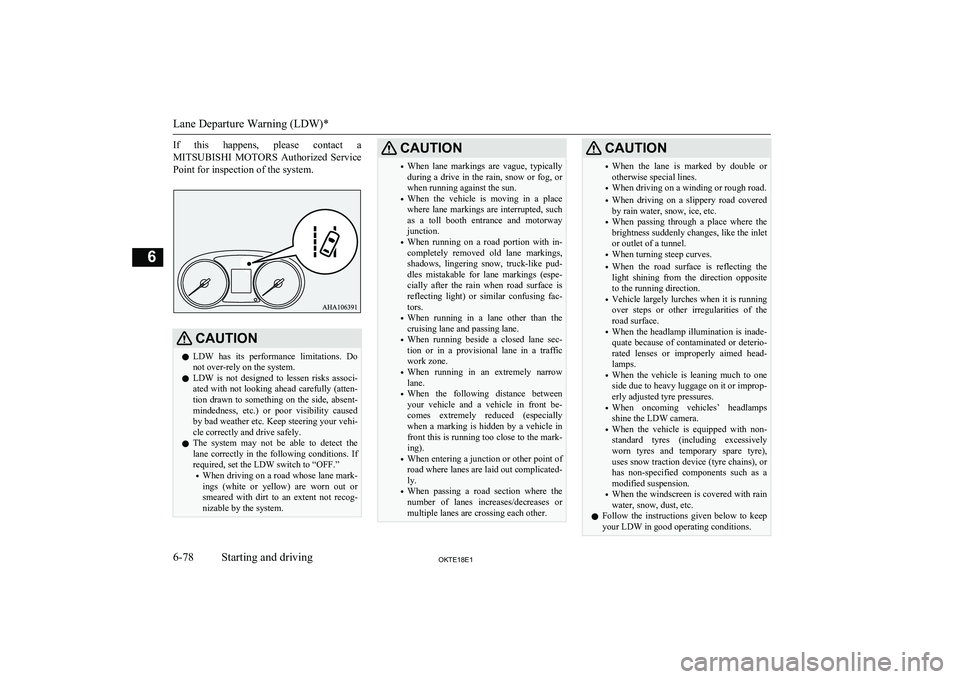
If this happens, please contact aMITSUBISHI MOTORS Authorized Service
Point for inspection of the system.CAUTIONl LDW has its performance limitations. Do
not over-rely on the system.
l LDW is not designed to lessen risks associ-
ated with not looking ahead carefully (atten-
tion drawn to something on the side, absent-
mindedness, etc.) or poor visibility caused
by bad weather etc. Keep steering your vehi-
cle correctly and drive safely.
l The system may not be able to detect the
lane correctly in the following conditions. If required, set the LDW switch to “OFF.”
• When driving on a road whose lane mark-
ings (white or yellow) are worn out or
smeared with dirt to an extent not recog- nizable by the system.CAUTION• When lane markings are vague, typically
during a drive in the rain, snow or fog, or when running against the sun.
• When the vehicle is moving in a place
where lane markings are interrupted, such
as a toll booth entrance and motorway junction.
• When running on a road portion with in-
completely removed old lane markings,
shadows, lingering snow, truck-like pud- dles mistakable for lane markings (espe-cially after the rain when road surface is
reflecting light) or similar confusing fac- tors.
• When running in a lane other than the
cruising lane and passing lane.
• When running beside a closed lane sec-
tion or in a provisional lane in a traffic work zone.
• When running in an extremely narrow
lane.
• When the following distance between
your vehicle and a vehicle in front be- comes extremely reduced (especially
when a marking is hidden by a vehicle in front this is running too close to the mark-
ing).
• When entering a junction or other point of
road where lanes are laid out complicated- ly.
• When passing a road section where the
number of lanes increases/decreases or multiple lanes are crossing each other.CAUTION• When the lane is marked by double or
otherwise special lines.
• When driving on a winding or rough road.
• When driving on a slippery road covered
by rain water, snow, ice, etc.
• When passing through a place where the
brightness suddenly changes, like the inlet or outlet of a tunnel.
• When turning steep curves.
• When the road surface is reflecting the
light shining from the direction opposite
to the running direction.
• Vehicle largely lurches when it is running
over steps or other irregularities of the
road surface.
• When the headlamp illumination is inade-
quate because of contaminated or deterio-
rated lenses or improperly aimed head- lamps.
• When the vehicle is leaning much to one
side due to heavy luggage on it or improp-
erly adjusted tyre pressures.
• When oncoming vehicles’ headlamps
shine the LDW camera.
• When the vehicle is equipped with non-
standard tyres (including excessively
worn tyres and temporary spare tyre), uses snow traction device (tyre chains), or has non-specified components such as a
modified suspension.
• When the windscreen is covered with rain
water, snow, dust, etc.
l Follow the instructions given below to keep
your LDW in good operating conditions.
Lane Departure Warning (LDW)*
6-78OKTE18E1Starting and driving6
Page 342 of 466
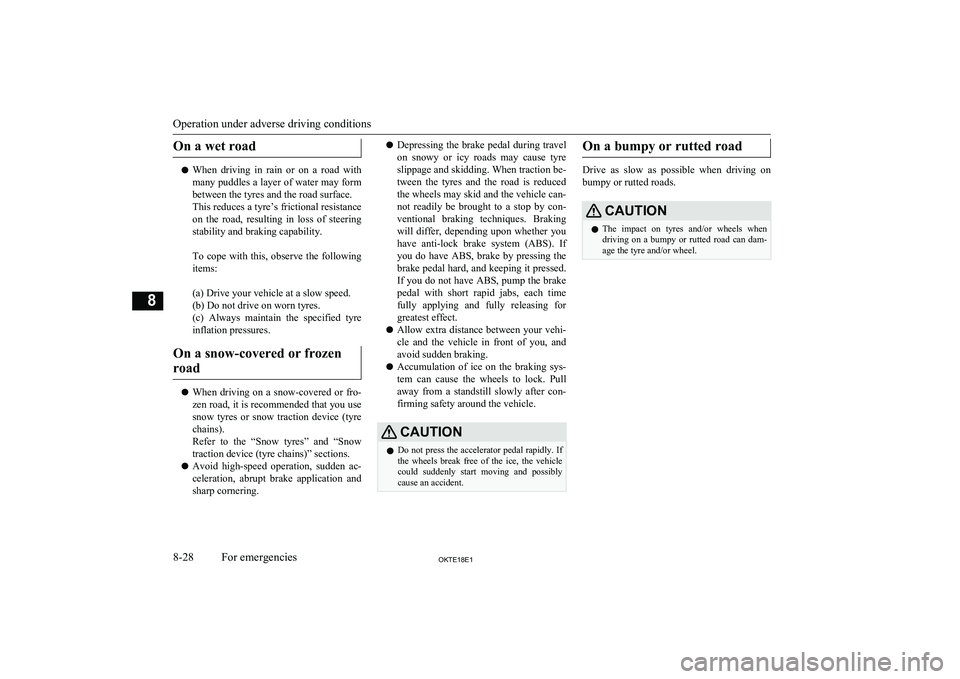
On a wet road
lWhen driving in rain or on a road with
many puddles a layer of water may form
between the tyres and the road surface.
This reduces a tyre’s frictional resistance on the road, resulting in loss of steering stability and braking capability.
To cope with this, observe the following
items:
(a) Drive your vehicle at a slow speed. (b) Do not drive on worn tyres. (c) Always maintain the specified tyre inflation pressures.
On a snow-covered or frozen road
l When driving on a snow-covered or fro-
zen road, it is recommended that you use
snow tyres or snow traction device (tyre chains).
Refer to the “Snow tyres” and “Snow
traction device (tyre chains)” sections.
l Avoid high-speed operation, sudden ac-
celeration, abrupt brake application and
sharp cornering.
l Depressing the brake pedal during travel
on snowy or icy roads may cause tyre
slippage and skidding. When traction be-
tween the tyres and the road is reduced
the wheels may skid and the vehicle can- not readily be brought to a stop by con-
ventional braking techniques. Braking will differ, depending upon whether you have anti-lock brake system (ABS). Ifyou do have ABS, brake by pressing the
brake pedal hard, and keeping it pressed. If you do not have ABS, pump the brake
pedal with short rapid jabs, each time
fully applying and fully releasing for
greatest effect.
l Allow extra distance between your vehi-
cle and the vehicle in front of you, and avoid sudden braking.
l Accumulation of ice on the braking sys-
tem can cause the wheels to lock. Pull
away from a standstill slowly after con- firming safety around the vehicle.CAUTIONl Do not press the accelerator pedal rapidly. If
the wheels break free of the ice, the vehicle
could suddenly start moving and possibly
cause an accident.On a bumpy or rutted road
Drive as slow as possible when driving on
bumpy or rutted roads.
CAUTIONl The impact on tyres and/or wheels when
driving on a bumpy or rutted road can dam-
age the tyre and/or wheel.
Operation under adverse driving conditions
8-28OKTE18E1For emergencies8
Page 362 of 466
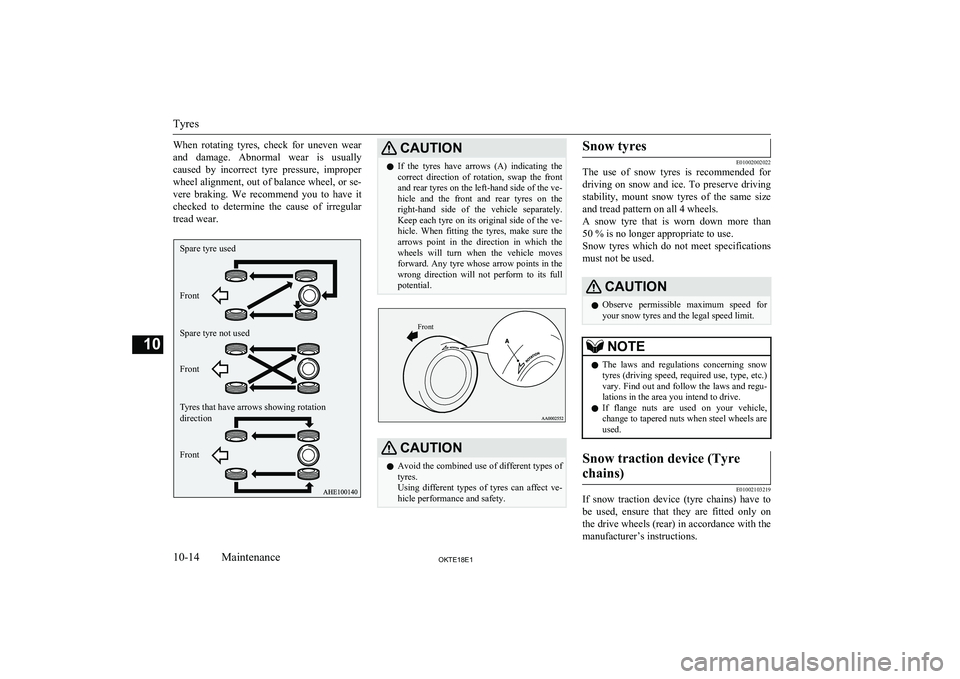
When rotating tyres, check for uneven wear
and damage. Abnormal wear is usually caused by incorrect tyre pressure, improper wheel alignment, out of balance wheel, or se-
vere braking. We recommend you to have it checked to determine the cause of irregular
tread wear.CAUTIONl If the tyres have arrows (A) indicating the
correct direction of rotation, swap the front
and rear tyres on the left-hand side of the ve- hicle and the front and rear tyres on the right-hand side of the vehicle separately.
Keep each tyre on its original side of the ve- hicle. When fitting the tyres, make sure the
arrows point in the direction in which the wheels will turn when the vehicle moves
forward. Any tyre whose arrow points in the wrong direction will not perform to its fullpotential.Front
CAUTIONl Avoid the combined use of different types of
tyres.
Using different types of tyres can affect ve-
hicle performance and safety.Snow tyres
E01002002022
The use of snow tyres is recommended for
driving on snow and ice. To preserve driving stability, mount snow tyres of the same size and tread pattern on all 4 wheels.
A snow tyre that is worn down more than
50 % is no longer appropriate to use.
Snow tyres which do not meet specifications must not be used.
CAUTIONl Observe permissible maximum speed for
your snow tyres and the legal speed limit.NOTEl The laws and regulations concerning snow
tyres (driving speed, required use, type, etc.)
vary. Find out and follow the laws and regu- lations in the area you intend to drive.
l If flange nuts are used on your vehicle,
change to tapered nuts when steel wheels are used.Snow traction device (Tyre
chains)
E01002103219
If snow traction device (tyre chains) have to
be used, ensure that they are fitted only on
the drive wheels (rear) in accordance with the manufacturer’s instructions.
Tyres
10-14OKTE18E1Maintenance10Spare tyre used
Front
Spare tyre not used
Front
Tyres that have arrows showing rotation
direction
Front
Page 363 of 466

On 4WD vehicles in which the driving poweris distributed preferentially to the rear
wheels, ensure that the snow traction device (Tyre chains) are fitted on the rear.
Use only snow traction device (Tyre chains)
which are designed for use with the tyres mounted on the vehicle: use of the incorrect size or type of snow traction device (Tyre
chains) could result in damage to the vehicle
body.
Contact a MITSUBISHI MOTORS Author-
ized Service Point before putting on a snow
traction device (tyre chains). The max. snow
traction device (tyre chains) height is as fol- lows.Tyre sizeWheel sizeMax. chain
height [mm]205R16C16x6 J,
16x6 JJ
22
245/70R1616x7 J,
16x7 JJ245/65R1717x7 1/2J
When driving with snow traction device (tyre
chains) on the tyres, do not drive faster than 50 km/h (30 mph). When you reach
roads that are not covered in snow, immedi-
ately remove the snow traction device (tyre
chains).
CAUTIONl Choose a clear straight stretch of road where
you can pull off and still be seen while you
are fitting the snow traction device (Tyre chains).
l Do not fit snow traction device (Tyre chains)
before you need them. This will wear out
your tyres and the road surface.
l After driving around 100-300 metres, stop
and retighten the snow traction device (Tyre chains).
l Drive cautiously and do not exceed 50 km/h
(30 mph). Remember that preventing acci-
dents is not the purpose of snow traction de- vice (tyre chains).
l When snow traction device (Tyre chains) are
installed, take care that they do not damage the disc wheel or body.
l An aluminium wheel can be damaged by a
snow traction device (Tyre chains) while
driving. When fitting a snow traction device (Tyre chains) on an aluminium wheel, take
care that any part of the snow traction device
(Tyre chains) and fitting cannot be brought into contact with the wheel.
l When installing or removing a snow traction
device (Tyre chains), take care that hands
and other parts of your body are not injured by the sharp edges of the vehicle body.
l Install the snow traction device (Tyre
chains) only on the rear tyres and tightenthem as tightly as possible with the ends se-
curely fastened.NOTEl The laws and regulations concerning the use
of snow traction device (tyre chains) vary. Always follow local laws and regulations.
In most countries, it is prohibited by the law to use of snow traction device (tyre chains)
on roads without snow.Wiper blade rubber
replacement E01008201449
1. Lift the wiper arm off the windscreen.2. Pull the wiper blade until its stopper (A)
disengages from the hook (B). Then, pull the wiper blade further to remove it.
NOTEl Do not allow the wiper arm to fall onto the
windscreen; it could damage the glass.
Wiper blade rubber replacement
10-15OKTE18E1Maintenance10
Page 406 of 466
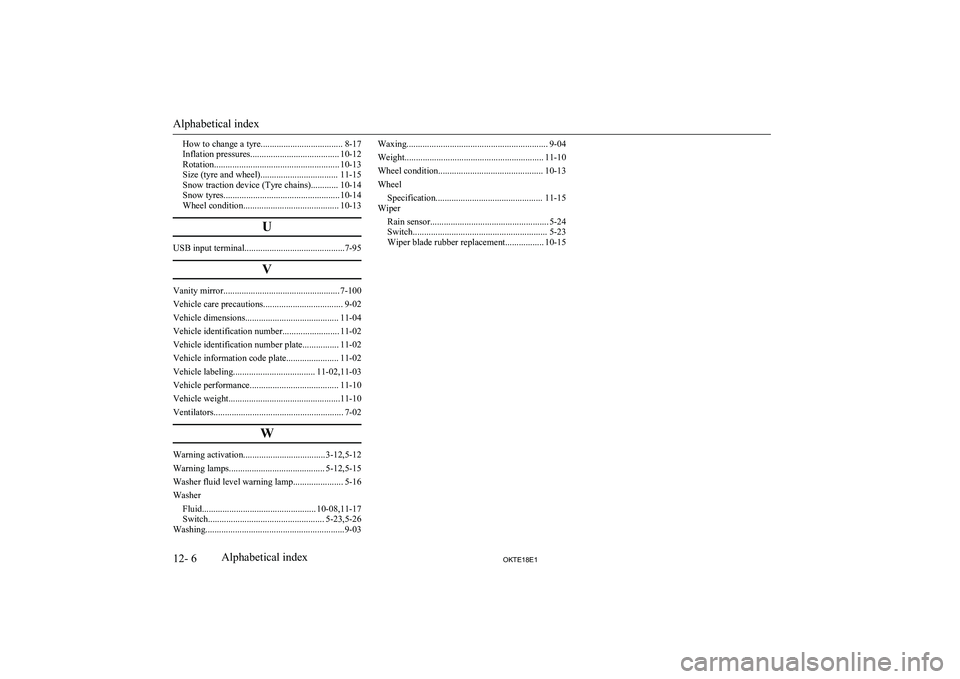
How to change a tyre.................................... 8-17
Inflation pressures....................................... 10-12
Rotation....................................................... 10-13
Size (tyre and wheel).................................. 11-15
Snow traction device (Tyre chains)............ 10-14
Snow tyres................................................... 10-14
Wheel condition.......................................... 10-13
U
USB input terminal............................................7-95 V
Vanity mirror................................................... 7-100
Vehicle care precautions................................... 9-02
Vehicle dimensions......................................... 11-04
Vehicle identification number......................... 11-02
Vehicle identification number plate................ 11-02
Vehicle information code plate....................... 11-02
Vehicle labeling.................................... 11-02,11-03
Vehicle performance....................................... 11-10
Vehicle weight.................................................11-10
Ventilators......................................................... 7-02
W
Warning activation.................................... 3-12,5-12
Warning lamps.......................................... 5-12,5-15
Washer fluid level warning lamp...................... 5-16
Washer Fluid.................................................. 10-08,11-17
Switch................................................... 5-23,5-26
Washing.............................................................9-03
Waxing.............................................................. 9-04
Weight............................................................. 11-10
Wheel condition.............................................. 10-13
Wheel Specification............................................... 11-15
Wiper
Rain sensor.................................................... 5-24Switch........................................................... 5-23 Wiper blade rubber replacement................. 10-15
Alphabetical index
12- 6 OKTE18E1Alphabetical index